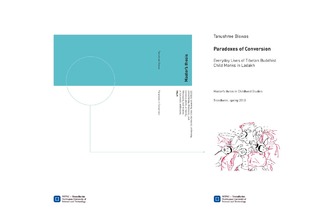| dc.description.abstract | Converting to modernity does not only imply changing what one does and how, rather it involves changes in one's relationship with existence as a whole. Every culture is founded upon metaphysical presuppositions which determine the way its people relate to each other including children and childhood, and the environment that they are part of. Consequently, I view cultures as an ecosystem. Restructuring and inserting new elements (schooling, tourism, consumer economy and so on) which are founded upon different metaphysical presuppositions cause a considerable strain on the roots of the ecosystem. This is especially true if the compatibility threshold between the two systems is low. Modernity is based on a linear understanding of causality, while the culture in question is founded on a cyclical understanding of causality. Some of the practical implications of this strain emerge in this study.
The belief in rebirth and practices around it stem from a cyclical understanding of causality. No child is born a tabula rasa, and is in fact a continuation of previous cycles. For debates in childhood studies around the 'being and becoming' nature of children and childhood – this understanding opens the door to a fresh consideration – that both adults as well as children are processionary becomings. This does not imply a necessary acceptance of the hypothesis of rebirth, but discards the possibility of being born as a tabula rasa. As a young project, the thesis is unable to present a definition of childhood as distinct from adulthood. However, it takes the position that no one is born a tabula rasa.
Monasteries are an indispensable part of Ladakh. Ladakh is a peaceful, high altitude culture on the Indo Tibetan border and is experiencing accelerated growth towards globalisation, predominant representatives of which are schooling, tourism and television. This qualitative project tries to understand the everyday lives of child monks in a monastery, who play a pivotal role in social reproduction in the region. The monastic community, known as the sangha becomes an extension of the family for these children. The relation between the sangha and the lay community is based on values of reciprocal generosity. Schooling occupies the biggest space as child monks follow government syllabus and guidelines. However, it is debatable whether this model of education is working for child monks and aiding them in performing their roles in a modern scenario. The monk, the school child and an exotic part of the touristscape are some identities that these children have to ebb and flow through.
Seen within the context of globalisation and the crises that come along with it, the will of children to adopt lives of simplicity is perceived as valuable. At the same time the text acknowledges that becoming a standardised global child and being a monk at the same time is a highly challenging paradox. | nb_NO |
